Wine for Beginners: A Simple Guide to Types and Tastes
Entering the world of wine for the first time can feel like learning a new language names, flavors, colors, and countless bottles to choose from. But it doesn’t have to be intimidating. This beginner’s guide will help you understand the basic types of wine, what they taste like, and how to start enjoying them with confidence.
What Is Wine, Really?
At its core, wine is fermented grape juice. But the grapes used for wine (known as Vitis vinifera) are different from table grapes. The fermentation process — where yeast turns grape sugar into alcohol — creates the magic.
Wine can be dry or sweet, light or bold, fruity or earthy. Understanding a few key categories will help you navigate wine aisles and menus with ease.
The Five Main Types of Wine
1. Red Wine
Made from dark-colored grapes with the skins included during fermentation, red wines often have bolder flavors and more tannins.
Common types:
- Cabernet Sauvignon – Bold, full-bodied, with dark fruit and spice
- Merlot – Smooth, medium-bodied, with plum and chocolate notes
- Pinot Noir – Light-bodied, with red berries and earthy undertones
2. White Wine
Produced from green or light-colored grapes, and usually fermented without the skins, white wines are generally crisper and lighter.
Common types:
- Chardonnay – Can be buttery and rich or clean and citrusy
- Sauvignon Blanc – Crisp, herbal, and citrusy
- Riesling – Light, aromatic, and can be dry or sweet
3. Rosé Wine
Rosé is made by letting red grape skins touch the juice briefly, giving the wine a pink color. It offers the fruitiness of red with the freshness of white.
Flavor profile: Dry to slightly sweet, with notes of strawberries, watermelon, and herbs.
4. Sparkling Wine
This is wine with bubbles, created by a second fermentation process.
Types include:
- Champagne (France)
- Prosecco (Italy)
- Cava (Spain)
These wines are lively, refreshing, and often enjoyed during celebrations.
5. Dessert or Sweet Wines
These wines contain more sugar and are usually served after meals.
Examples include:
- Port – Rich, fortified, often enjoyed with chocolate
- Sauternes – Honeyed, sweet white from France
- Moscato – Light, sweet, and slightly sparkling
Understanding Wine Taste
Wine taste comes from a combination of fruit, acidity, tannins, sweetness, and alcohol. Here’s what to look for:
- Fruity: You might taste cherry, apple, blackberry, citrus, or even tropical fruits.
- Acidity: Makes wine feel crisp and refreshing (common in white wines).
- Tannins: Give a dry, puckering sensation in the mouth (mainly in reds).
- Sweetness: Ranges from bone dry to syrupy sweet.
- Alcohol: Adds warmth and body to the wine.
How to Describe What You Taste
Start with these easy categories:
- Fruit: Red fruits (strawberry, cherry), black fruits (blackberry, plum), citrus (lemon, lime)
- Floral or Herbal: Rose, jasmine, eucalyptus, mint
- Spice: Pepper, clove, cinnamon
- Earthy: Leather, tobacco, wet stone, forest floor
Practice by smelling and tasting slowly. Don’t worry about being “wrong.” It’s personal.
Dry vs Sweet: Know the Difference
Many beginners assume white wines are always sweet and reds are always dry — but that’s not true.
- Dry wine: Has little to no sugar. Most wines fall into this category.
- Sweet wine: Contains noticeable residual sugar.
- Off-dry or semi-sweet: In between the two.
Check the label or ask for help when choosing.
Beginner-Friendly Wines to Try First
Not sure where to begin? These wines are great starting points:
- Pinot Noir: Light red, fruity, easy-drinking
- Merlot: Smooth and approachable
- Sauvignon Blanc: Fresh, citrusy white
- Moscato: Sweet and slightly sparkling
- Rosé: Refreshing and versatile
Look for bottles under $20 to keep it affordable while exploring.
Try a Wine Tasting Flight
If you go to a wine bar, ask for a tasting flight — small pours of 3 to 5 wines. This is a great way to compare styles and see what you enjoy most.
Tip: Take notes on what you like (grape, region, flavor). That info will guide future purchases.
Don’t Stress Over the Perfect Pairing
While wine and food pairings can elevate your meal, don’t overthink it. Some general rules:
- Red wines = meat, hearty dishes
- White wines = fish, salads, light pasta
- Sparkling = salty foods or appetizers
- Sweet wines = desserts
Experiment and adjust to your taste.
Build Confidence Over Time
You don’t need to become a wine expert overnight. Try different wines, read labels, ask for recommendations, and stay curious.
The more you taste and learn, the more confident and comfortable you’ll feel. Your personal preferences will become clearer — and that’s when the real fun begins.






